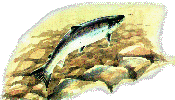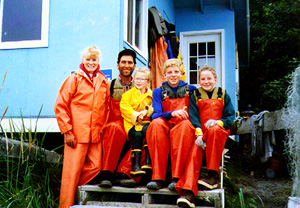Alaskans depend on our state's multitude
of natural resources for many things, including housing,
fuel and food. Many also depend on Alaska's bountiful
resources for their livelihood. Such is the case with the
Leman family, going back many generations to the Aleuts and
Alutiiqs who inhabited Kodiak and Afognak Islands, and other
coastal areas of southcentral Alaska.
Fishing is an important livelihood in Ninilchik, where I was
raised. I have fished for salmon with my family since my
childhood. Since 1959, when Alaska became a state, we have
used set gill nets close to shore in Cook Inlet. Before
that, Dad fished in the same area with a fishtrap.
We currently have three generations in our family actively
fishing together.

Loren, Joseph & Nick
Fish site near Ninilchik, Alaska
August 1997
During the short salmon fishing season in July and August,
our family joins together at Ninilchik Point to participate
in the fishing harvest.
The setnet fishery is hard work, but rewarding as a family
activity. Fishing usually opens for short, intense 12-hour
periods on Monday and Friday. Sometimes these times are
extended and there is little opportunity for sleep.
Fishing is affected by the tides and wind. A good harvest
can be hit and miss. Sometimes the salmon run bypasses our
nets. At other times the harvest is plentiful, and there is
a great deal of jubilation!
|
The State of Alaska carefully manages our
fishery resources. Sonar counters on major river
systems count the number of salmon in freshwater.
Test fishing is also ongoing during the summer
season in saltwater. The Department of Fish &
Game follows policies established by the Board of
Fisheries and manages fishing opportunity to meet
target "escapement" levels in the Kasilof and Kenai
rivers. |
Every family member is important to the effort. In addition,
we are joined by crew who help out with the effort.
Fishing at our site includes setting and pulling gear as
well as harvesting fish. However the most time-consuming,
backbreaking work is cleaning (picking) the nets. A great
deal of seaweed moves with the tide near shore in this area
of Cook Inlet. It is a constant chore to remove this moss
and kelp from our nets. If this is not done, fish see the
nets and do not get caught. Sometimes the seaweed will sink
or break nets.
 Carolyn and our daughter Rachel cook for the
fishing crew. Feeding 4-5 hungry men and growing boys is a
challenge! They do this without electricity or an onsite
refrigerator or freezer. We enjoy fresh fish and eat it
often.
Carolyn and our daughter Rachel cook for the
fishing crew. Feeding 4-5 hungry men and growing boys is a
challenge! They do this without electricity or an onsite
refrigerator or freezer. We enjoy fresh fish and eat it
often.
A recent improvement to our water supply now enables us to
have running water in the cabin!

Carolyn, Loren, Nicole, Joseph & Rachel
Ninilchik beach cabin: Summer 1997
Rachel is a valuable participant. She
often picks the fish and trash from the beach nets that have
gone dry when the tide ebbs and also helps out in the skiff,
usually with her father.
Nicole provides the comic relief and delight that young
children can bring! She is good with fetching and carrying,
especially when she can use her all-terrain vehicle to help
with the job!
Visitors are welcome at our fishing site. Some are even brave enough to help with the work for a few hours to get some fishing experience!